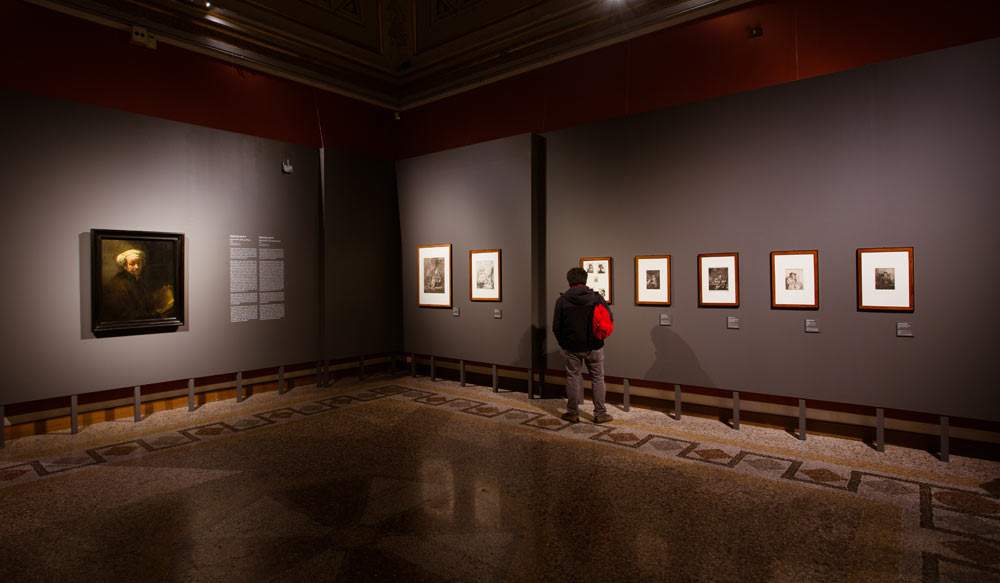Museums closed, CGIL: "measures were congruous. But reopening will not mean restarting."
We are publishing today the first part of our “conversation” with civil service unions in cultural heritage about museum closures. Here are the answers from Claudio Meloni, coordinator of CGIL Funzione Pubblica Beni Culturali. They will be followed in the coming days by CISL, UIL and Confintesa.
 |
| Visitor to the Rembrandt exhibition at the Corsini Gallery in Rome during the Covid period. Ph. Ministry of Culture - DG Museums |
On the closures of museums, it has been said that the decision was made to limit opportunities for contagion, but there are studies that say that, in observance of the measures to contain contagion, they are the safest places ever, and after all, the experience of Spain (where several museums never closed) teaches that the opening of cultural venues could easily coexist with the containment of Covid-19. What is your position on the issue of indiscriminate museum closures?
As far as reopenings are concerned, we think that they can take place under safe conditions. But this is not about internal security measures at cultural venues. We have signed two security protocols, one concerns closed-site measures and the other open-site measures, which have worked. So in general there are no problems from the point of view of securing cultural sites, and the decisions made that arrange closures obviously have a more general context of reference. We have already started in the so-called Phase 2 of the pandemic the reopenings: we believe that, subject to the known structural deficits of the ministry, the system is able to restart safely. Of course, with full respect for the decisions that the CTS and the Ministry of Health will make in this regard, and we frankly do not believe that the measures taken so far have not been congruous or have discriminated against cultural venues.
Why do you think there has not been at least a difference between large and small museums? There are large and highly toured museums in the historic centers of large cities (such as the Uffizi, the Egyptian Museum in Turin, or the civic museums in Venice, for example), but there are also small museums in the provinces, easily reached by the public and workers, and already little visited in their own right.
The difference may be in the size of the museums but not only. For example, the entropic conditions of security in relation to the specificity of the site. But it cannot become a general criterion for that reason. In any case, the criteria chosen are others and are related to the levels of gradation that the state of the pandemic determines. If an area becomes red, the reflections with respect to closures and openings of public offices, schools and productive activities are obvious. Thus, considering the gradations of the last period, very little would have been affected by this criterion.
For large cities, it has been said that the problem is mainly in transportation and especially affects workers. Have you ever asked the ministry or the entities that run the museums to have employees reimbursed for travel by their own means in order to avoid having them take public transportation?
Mobility has always been guaranteed for travel to the workplace. We do not believe that incentivizing the use of one’s own means of transportation is the solution, and in any case, a regulatory change would be needed to meet this demand, as it is certainly an unconsidered case. Currently, for example, the use of one’s own vehicle for missions is almost prohibited, and in any case it should be a general measure for all those who travel for work purposes. Unfortunately, there are no simplified solutions in this situation.
Have there been any public employees who have asked your union to open museums? If so, what percentage?
We have not had great requests in this regard. Also because the problem unfortunately generally concerns outsourced workers in the cultural supply cycles and much less internal workers. Often the contingents of internal workers are barely enough to cover the security garrisons.
What do you think needs to be done to open a museum safely?
Enforce current security protocols.
Have you lobbied or are you lobbying the Ministry of Culture to ask that everything be reopened as soon as possible, logically safely and in compliance with current protocols?
We would like to see the reopenings of the cultural sites, and we believe that the increase in the announced vaccination campaign can enable them. That is why we have maintained the 2021 Enhancement Plan and will do our part to have it implemented. We certainly hope that it can happen soon-thousands of workers are stuck in layoffs or expelled from the labor market. Reopening will not mean restarting, and what concerns us today is that the Ministry will not be able to ensure its services because of the very serious shortage of staff. Instead, we need to ensure a public service that can hold up and qualify. There is a great opportunity with the resources coming in from Europe, there is a risk that we will not know how to use them properly if we do not take immediate action with an extraordinary employment plan.
 |
| Museums closed, CGIL: "measures were congruous. But reopening will not mean restarting." |
Warning: the translation into English of the original Italian article was created using automatic tools. We undertake to review all articles, but we do not guarantee the total absence of inaccuracies in the translation due to the program. You can find the original by clicking on the ITA button. If you find any mistake,please contact us.





























